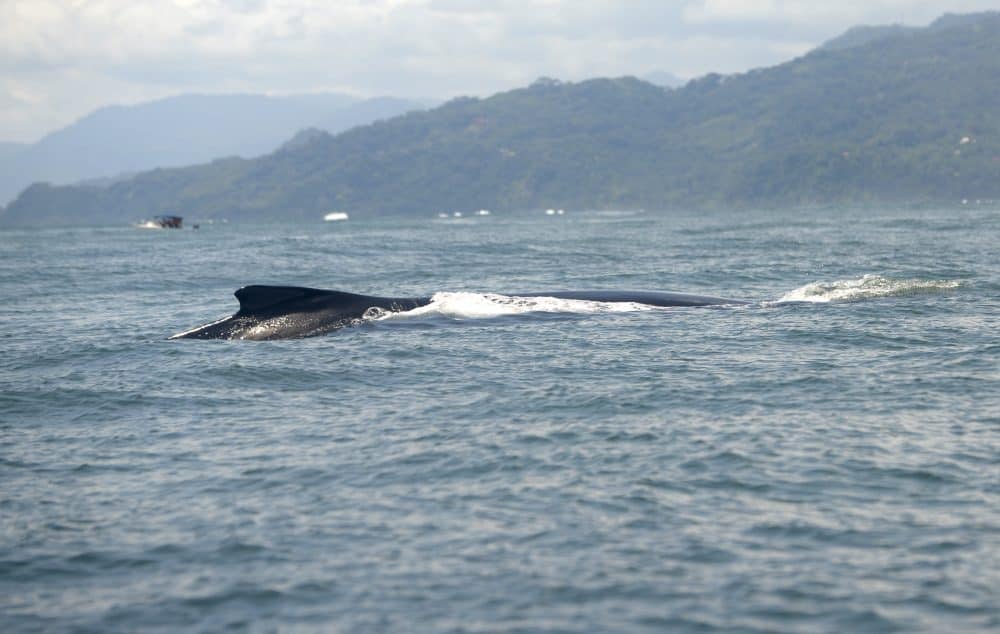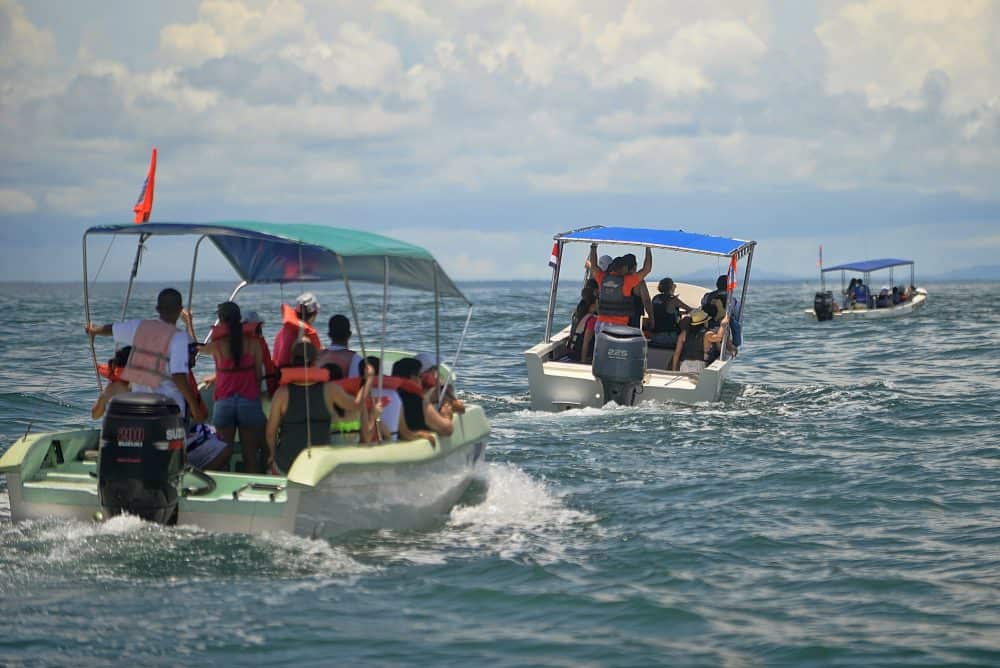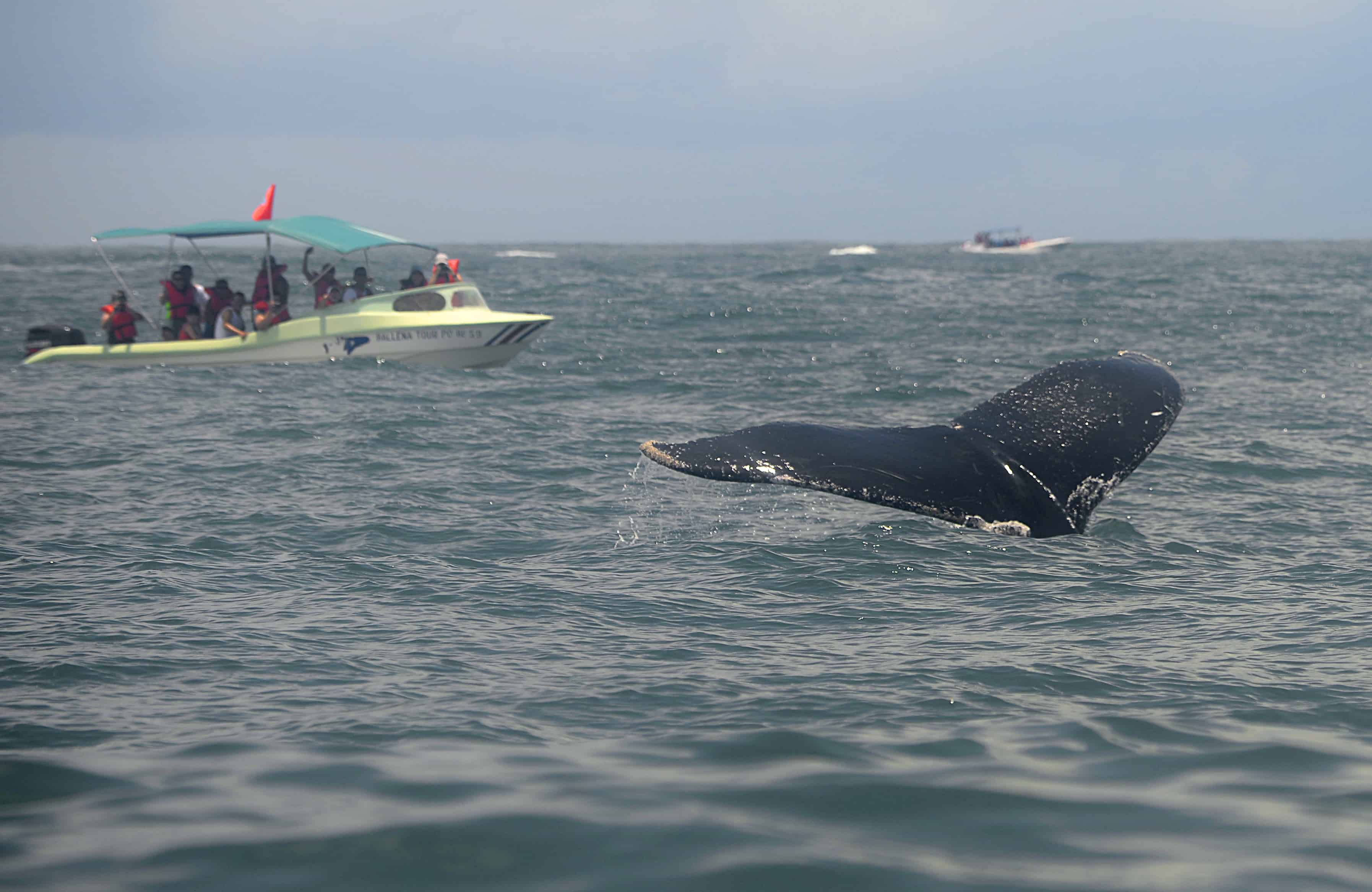Nestled under palm trees and mounds of white sand, the concrete slabs and rusted iron support beams seem out of place—an eyesore in what would otherwise be paradise. Years ago, however, those ruins were the economic backbone of the tiny southern Pacific fishing village of Uvita. As a fish processing plant, the building served as a hub for the community’s 30-some fishing families for decades, until concerns about the whales arose.
Home to a sizeable population of Pacific humpbacks, Uvita became a site of environmental concern. Decades ago, Costa Rica cordoned off the town’s coastline to form Marino Ballenas National Park. This decree granted environmental protection to Uvita Beach and banned fishing along the coast, forcing most fishermen to hang up their nets.
Rather than being forced out, the fishermen of Uvita reinvented themselves. Today, anyone can board one of Uvita’s former fishing boats for a whale watching tour. Last weekend alone, 2,000 people participated in the 6th Annual Whale and Dolphin Festival, with organizers expecting to provide 10,000 tours by the festival’s close on September 14. Once reliant on inconsistent commercial fishing, Uvita is now almost entirely dependent on tourism, and the whale economy is booming.
Fleeing the frozen winters of the Antarctic and Arctic oceans, Pacific humpback whales travel up to 5,000 miles yearly to reach warmer waters for breeding and giving birth. Situated near the equator, the tropical waters of the Central American coast draw both northern Pacific humpbacks from December to April and southern Pacific humpbacks from August through November. Many of these whales travel to Costa Rica’s South Pacific, where protected coves provide safe haven for mothers to train their new calves.
In the late 1980s, in hopes of protecting whales from the country’s growing fishing industry, Costa Rica’s Environment Ministry began searching for a site to create a whale sanctuary. Few places in the South Pacific stood out like Uvita.

The small village’s coastline boasts a rich diversity of threatened coral species and protected coves. At high tide, Uvita Beach looks like any other in the country’s South Pacific. But at low tide, the waves recede, revealing a jutting arm of sand sweeping out into the ocean in the unmistakable shape of a whale’s tail. It was as though fate had designated the beach as a whale sanctuary. On December 14, 1989, Marino Ballena National Park was founded, comprising a significant portion of the coastline and over 20 square miles of ocean territory.
In the park’s early days, fishermen struggled to make ends meet with the new regulations. Banned from fishing the coastline, they ventured further into the ocean, using more gas and facing greater risks. Once they reached deeper waters, their small boats faced competition from industrial shrimp trawlers, which consumed much of the available catch. With no production or agriculture in the area, Uvita families had few options.
“For years, the park was considered an enemy of the community,” said Fernando Guerrero, one of Marino Ballena’s first park rangers. “People saw it as a threat to their livelihood, and there was a lot of tension between the community and the Environment Ministry.”
Julio Badilla, a former fisherman, recalls the early 1990s as Uvita’s dark days. Few people had work, and a general malaise spread throughout the community. Tensions escalated between Uvita residents and the Environment Ministry. Park rangers received threats from locals, and illegal fishing operations ran rampant within the park’s boundaries. Some families left Uvita in search of opportunities elsewhere. The conflict finally boiled over when angry residents burned down the home of a park ranger.
“That was the breaking point,” Badilla said.
The Environment Ministry hired mediators to work with the community and helped three fishermen open small tour operations in the park. Badilla was among the first to join, launching his company, Dolphin Tour, with one small fishing boat. Throughout the ’90s, more tour businesses opened, but Uvita remained a rustic, mostly local tourist destination for years. In 2000, the first electricity lines arrived, and the town began to transform.
According to Costa Rica’s National System of Conservation Areas (SINAC), the Uvita area attracted 67,000 tourists in 2007. In 2009, tour operators organized the first Whale and Dolphin Festival. The following year, construction finished on the coastal highway, linking Uvita and surrounding communities to Costa Rica’s main road system, cutting the commute from San José from six hours to three and a half. By 2011, the number of visitors had doubled, and today more than 140,000 tourists travel to Uvita each year, almost all drawn by the whales.
“The tours became a model for further development rather than just an alternative to fishing,” Guerrero stated. “This is an economic system for the community, created by the community.”
On September 6, the Whale and Dolphin Festival was in full swing on Uvita Beach. Hundreds of people milled about the park’s entrance, carrying cameras and binoculars while lathering on sunscreen. More than 95 percent of the tourists are Ticos, families down from San José for the weekend or a spur-of-the-moment trip.
“I got on my motorcycle this morning in Alajuela to go to the store and saw the festival sign and drove right down,” said one excited man as he pulled on his life vest to board the boat. “It was completely unplanned.”
Tourists shelled out ₡20,000 (about $38) for two hours of whale watching. September is peak month for sightings, and it’s rare for a boat to return without encountering at least one whale. Most common are mothers and calves who stick closer to the surface, but occasionally, a captain will spot a male leaping from the water in a breeding display.
There are now 19 whale tour companies in Uvita, all participating in the Whale and Dolphin Festival. Organizers estimate that tours alone will bring in about $380,000 during the two-week festival.
“The real advantage of this festival is the branching effect of the tourism dollar,” said Ulises Ramírez, the festival’s organizer and a member of the Association of Tour Operators (Asotur). “This doesn’t just benefit the tour operators, but also the informal sector—people selling coconuts or T-shirts on the side of the road. The park has economic implications for the entire region.”
While hotels, restaurants, and other types of tours also contribute significantly to the economy, Asotur members assert that 90 percent of Uvita’s economy ultimately relies on the park’s ability to attract visitors. Business owners in the area tend to agree.
Just up the road at the entrance to Uvita, the travel agency Costa Rica Te Enamora has embraced the town’s image, crafting their office building into the shape of a giant humpback. Inside, volunteer Deborah Allainito noted that nearly all the tours they sell for Uvita are related to whales or dolphins.
“I would say most people who come here come expecting to see whales,” said Tra McPeak, owner of the Tucan Hotel, a local hostel. “If it weren’t for the park, this place would not be what it is.”
The whales’ two migrating seasons also provide Uvita’s tourism economy with unusual stability. From May to November, most businesses see a drop during the rainy season, but the whales keep people coming. Several tourism business owners reported having their best August on record this year, and they claim things have steadily improved since the festival began six years ago. This switch to tourism has granted economic security to the community that fishing never provided.
“When you take out a boat of tourists, the tourists pay. You know you are getting money,” Badilla said. “When you go out fishing, you never know what will happen. For everyone here, things are much, much better.”
Out in the water, five different boats form a semi-circle around a dark shadow moving beneath the surface. The shadow grows darker as the creature rises to the surface. A mother humpback tips her back out of the water, exposing a blueish-gray dorsal fin and a massive blowhole the size of a trash can. The whale shoots out steam with an audible sigh before submerging again, flipping her tail as she goes down.

This year’s festival features a larger number of companies and more tickets sold than ever before.
The high volume of tours prompted one non-governmental organization, Costa Rica Forever, to donate $75,000 for additional coastal monitoring, while other NGOs contributed their time to educate tour operators. However, mismanaged coastal developments continue to threaten the park’s health, and Uvita’s tourism industry must walk a fine line between healthy progress and overdevelopment that could harm their eco-tourism industry. The town had already approached that line once, during the golden age of Costa Rican tourism before the 2008 financial crash.
In the months leading up to the financial crash, Marino Ballena Park Administrator Juan Luis Sánchez recalls flying over Uvita to see the burgeoning million-dollar developments along the coast.
“We looked down near the coast and counted 18 backhoes tearing down trees very close to the park,” he said. “That sort of thing is worrying.”
With the recession, most large projects were canceled, but the potential for explosive development remains. Some in Uvita favor more tours, hotels, and large-scale projects, while environmentalists and whale experts worry that overdevelopment could do more harm than good. Poorly constructed coastal developments can cause land shifts that may damage the park and deter whales, while increased whale watching can induce






